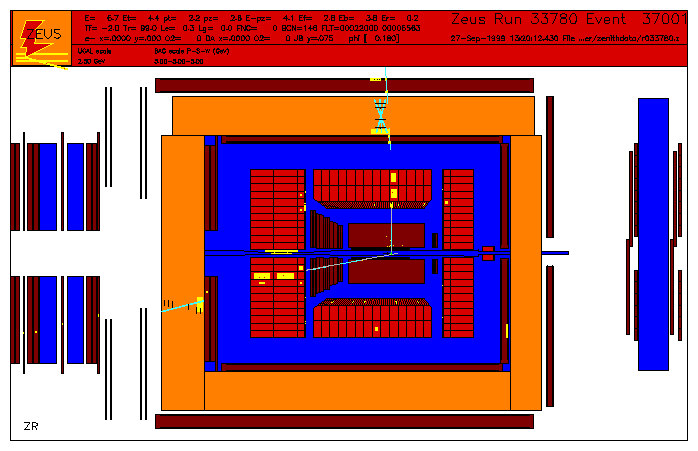General MUON finding in ZEUS using ORANGE


This page was created by Achim Geiser. Last update 2/05/07
Ideally, at a later stage, the information from all subdetectors might be combined into a single muon finder taking into account all their correlations.
Card default description
DOMUON OFF enables muon finding in general
DOMUON1 ON enable old (pre-2003) simple muon finders
DOMUON2 ON enable new sophisticated muon finders
MUZUFO OFF use muons for ZUFO corrections
MUJETA OFF calculate Muon association to jet type A
NTMUON OFF enable old MUON ntuple block
NTGMUON OFF enable new GMUON ntuple block
NTGMUJET OFF include muon-jet information into GMUON
NTMUMC OFF include muon MC information into GMUON
NTMUQU 2 only store muons with quality flag >= value (not yet implemented)
DOBAC OFF enable muon finding based on BAC (J. Sztuk)
NTBAC OFF store detailed MUBAC information (J. Sztuk)
NTBREMAT OFF store detailed BREMAT information (G. Abbiendi)
NTMPMAT OFF store detailed MPMATCH/MFRTZ/MFCTS information (M. Corradi)
NTMV OFF store detailed MV information (V. Kuzmin)
In addition there are cards for invidual packages and for GEANE initialization
for expert use.
*** For the moment, whenever DOMUON2 is ON, a set of GEANT and BREMAT cards needs to be added. ***
These are needed for the proper functioning of BREMAT, MUFO, and MPMATCH.
Solutions to replace this by a default initialization are under study.
Examples for use of cards:
The minimum setting for non-expert users which do not need backwards
compatibility with pre-2003 versions of the ntuple is
DOMUON ON
NTGMUON ON
DOBAC ON
add the GEANT and BREMAT cards
set the approriate trigger date for the corresponding year
(see GEANT cards)
This will switch on all essential features, and yield a GMUON block
containing all the necessary basic information.
If information on muon isolation is wished the card
ORANGE-NTBLOCKS GMU_ISOL
will make this information available in the GMUON block
If information on muon-jet association is wished, and some jet finder is
enabled the cards
ORANGE-NTBLOCKS GMU_JET
or NTGMUJET ON
will make this information available in the GMUON block, separately for
jet blocks A, B, C, and D.
If simulated true information on muons is wished the card
ORANGE-NTBLOCKS GMU_MC
or NTMUMC ON
will make this information available in the GMUON block
For experts wishing more detailed information, a selection from the cards
NTMUON ON (for GLOMU, MAMMA, MIP)
NTBAC ON
NTBREMAT ON
NTMPMAT ON
NTMV ON
will switch on additional expert blocks from the respective finders
If zufos are enabled, and are to be corrected for the muon mip deposit,
the card
MUZUFO ON
should be enabled.
To enable the zufo dead material correction (NOT to be used in conjunction
with any other jet corrections), use
ORANGE-ZUFODMCO ON
Be careful with the use of ZUFORMVE ON (electron removal) since this removes all tracks in the vicinity of an electron from the zufo list, even if they belong to a muon! (best solution: DON'T use this flag).
To switch on all (or a selection of) GMUON and related ntuple blocks, you
can also use the new NTUPLE BLOCK notation
ORANGE-NTBLOCKS GMUON GMU_ISOL GMU_JET GMU_MC MUON BREMAT FMU_MPM FMUmfrtz MV BAC
For full backwards compatibility with the pre-2003 version of the ntuple
(now obsolete!), use
DOMUON ON
DOMUON2 OFF
NTMUON ON
This will switch off all new features, and yield a muon block identical to the
old one.
The setting to profit from the new GMUON block, with simultaneous
access to the "old" information for backwards compatibility, should be
DOMUON ON
NTMUON ON
NTGMUON ON
DOBAC ON
do not forget to add the GEANT and BREMAT cards
Expected efficiencies and event samples: Numbers do NOT yet include trigger and other selection efficiencies.
Beauty (from small inclusive PYTHIA bbbar sample):
Assume total bbbar cross section of ~10 nb.
-> 10^6 events for 100 pb^-1.
~ 200000 events with >= 1 prompt muon p>1 GeV and pT>0.5 GeV
~ 110000 events with reconstructed muon candidate, muon quality >=4
~ 90000 events with reconstructed prompt muon, muon quality >=4
~ 30000 events with rec. prompt muon qual>=4 ass. to jet pt>4 GeV (ptrel)
~ 2400 events with rec. prompt muon 5dof + 2 jets pt>6,7 GeV +p/pt cut
Beauty -> D*+muon: Selection with muon quality >= 4 doubles event sample (currently from BREMAT 4dof only) while keeping same signal/bg ratio.
W->munu: Either significant increase in efficiency (~30%) for similar purity, or significant increase in purity for same efficiency (=> loosen other cuts?).